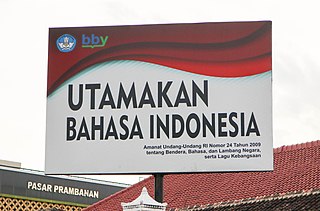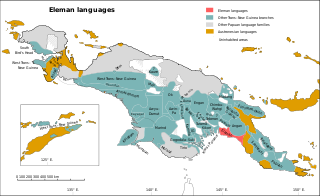
Papua New Guinea is a country in Oceania that comprises the eastern half of the island of New Guinea and its offshore islands in Melanesia. Officially the Independent State of Papua New Guinea, it shares its only land border with Indonesia to the west and it is directly adjacent to Australia to the south and the Solomon Islands to the east. Its capital, located along its southeastern coast, is Port Moresby. The country is the world's third largest island country, with an area of 462,840 km2 (178,700 sq mi).

Melanesia is a subregion of Oceania in the southwestern Pacific Ocean. It extends from New Guinea in the west to the Fiji Islands in the east, and includes the Arafura Sea.

Bougainville Island is the main island of the Autonomous Region of Bougainville, which is part of Papua New Guinea. It was previously the main landmass in the German Empire-associated North Solomons. Its land area is 9,300 km2 (3,600 sq mi). The population of the whole province, including nearby islets such as the Carterets, is approximately 300,000. The highest point is Mount Balbi, on the main island, at 2,715 m (8,907 ft). The much smaller Buka Island, c. 500 km2 (190 sq mi), lies to the north, across the 400–500 m (1,300–1,600 ft) wide Buka Strait. Even though the strait is narrow, there is no bridge across it, but there is a regular ferry service between the key settlements on either side. The main airport in the north is in the town of Buka.

The Papuan languages are the non-Austronesian languages spoken on the western Pacific island of New Guinea, as well as neighbouring islands in Indonesia, Solomon Islands, and East Timor by around 4 million people. It is a strictly geographical grouping, and does not imply a genetic relationship.

The indigenous peoples of Western New Guinea in Indonesia and Papua New Guinea, commonly called Papuans, are Melanesians. There is genetic evidence for two major historical lineages in New Guinea and neighboring islands: a first wave from the Malay Archipelago perhaps 50,000 years ago when New Guinea and Australia were a single landmass called Sahul and, much later, a wave of Austronesian people from the north who introduced Austronesian languages and pigs about 3,500 years ago. They also left a small but significant genetic trace in many coastal Papuan peoples.

The National Parliament of Papua New Guinea is the unicameral national legislature in Papua New Guinea. It was created in 1964 as the House of Assembly of Papua and New Guinea but gained its current name after the nation was granted independence in 1975.

The West Papuan languages are a proposed language family of about two dozen non-Austronesian languages of the Bird's Head Peninsula of far western New Guinea, the island of Halmahera and its vicinity, spoken by about 220,000 people in all. It is not established if they constitute a proper linguistic family or an areal network of genetically unrelated families.
The Lower Mamberamo languages are a recently proposed language family linking two languages spoken along the northern coast of Papua province, Indonesia, near the mouth of the Mamberamo River. They have various been classified either as heavily Papuanized Austronesian languages belonging to the SHWNG branch, or as Papuan languages that had undergone heavy Austronesian influence. Glottolog 3.4 classifies Lower Mamberamo as Austronesian, while Donohue classifies it as Papuan. Kamholz (2014) classifies Warembori and Yoke each as coordinate primary subgroups of the South Halmahera–West New Guinea languages.
The Ramu–Lower Sepika.k.a.Lower Sepik–Ramu languages are a proposed family of about 35 Papuan languages spoken in the Ramu and Sepik river basins of northern Papua New Guinea. These languages tend to have simple phonologies, with few consonants or vowels and usually no tones.

The Yawa languages, also known as Yapen languages, are a small family of two closely related Papuan languages, Yawa and Saweru, which are often considered to be divergent dialects of a single language. They are spoken on central Yapen Island and nearby islets, in Cenderawasih Bay, Indonesian Papua, which they share with the Austronesian Yapen languages.
Tause, also known as Doa or Darha, is a poorly-known Papuan language of Indonesia spoken by approximately 500 people, mainly in Derapos village.

More than 700 living languages are spoken in Indonesia. This figure indicates that Indonesia has about 10% of the world's languages, establishing its reputation as the second most linguistically diverse nation in the world after Papua New Guinea. Most languages belong to the Austronesian language family, while there are over 270 Papuan languages spoken in eastern Indonesia. The language most widely spoken as a native language is Javanese.

The Eleman languages are a family spoken around Kerema Bay, Papua New Guinea.

The Engan, or more precisely Enga – Southern Highland, languages are a small family of Papuan languages of the highlands of Papua New Guinea. The two branches of the family are rather distantly related, but were connected by Franklin and Voorhoeve (1973).

The Bosavi or Papuan Plateau languages belong to the Trans-New Guinea language family according to the classifications made by Malcolm Ross and Timothy Usher. This language family derives its name from Mount Bosavi and the Papuan Plateau.

New Guinea is the world's second-largest island, with an area of 785,753 km2 (303,381 sq mi). Located in Melanesia in the southwestern Pacific Ocean, the island is separated from Australia by the 150-kilometre wide Torres Strait, though both landmasses lie on the same continental shelf. Numerous smaller islands are located to the west and east. The island's name was given by Spanish explorer Yñigo Ortiz de Retez during his maritime expedition of 1545 due to the resemblance of the indigenous peoples of the island to those in the African region of Guinea.
The Ottilien or Watam-Awar-Gamay languages languages are a small family of clearly related languages,
Yoke is a poorly documented language spoken by about 200 people in the north of Papua, Indonesia. The name is also spelled Yoki, Yauke, and it is also known as Bitovondo. It was spoken in a single village in the interior until the government relocated a third of the population to a new village, Mantarbori, on the coast. In the late 19th century, a word list of "Pauwi" was collected by Robidé van der Aa at Lake Rombebai, where the Yoke say they migrated from; this is transparently Yoke, apart from some words which do not appear in the modern language but are found in related Warembori.
The Tiang language, also known as Djaul, is a language spoken in Papua New Guinea.












